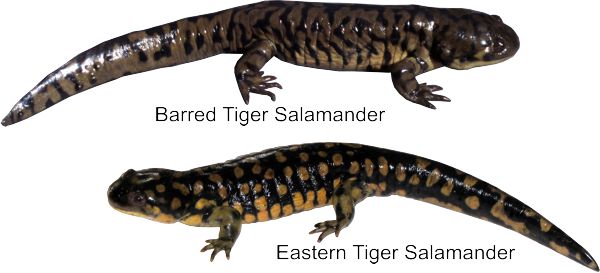
Raising Tigers! Tiger Salamanders, that is.
| By Doug Collicutt |
Raising critters, from egg to adult form, is something I've always loved doing. Over the years I've reared many kinds of butterflies and moths, a number of different frogs and toads, salamanders, turtles and even some kinds of small mammals (which don't start as eggs, I know.) You learn an awful lot by having such intimate contact and involvement with different species.
Check out the Salamander Cooperative! |
In the spring of 2016 I had the opportunity to collect some eggs of Eastern Tiger Salamanders (Ambystoma tigrinum) from a pond in southeastern Manitoba. I had reared these critters successfully before, but this time I wanted to record video and share the experience with others. (Like I did with Wood Frogs a couple of years ago: Wood Frogs)
Basic Biology of Eastern Tiger Salamanders
Two kinds of Tiger Salamanders can be found in Manitoba: the Barred Tiger (Ambystoma mavortium), west of the Red River Valley, and the Eastern Tiger (A. tigrinum) in the southeast, east of the Red River Valley. The Red River, running south to north in southern Manitoba, with its surrounding heavy clay soils of the Red River Valley, is a habitat barrier to both species which require loose, sandy soils and small lakes or ponds for breeding. The two kinds are currently considered to be distinct species, but in the past were thought to be just subspecies. Salamander taxonomy is not that clear-cut.

|
Eastern Tiger Salamanders (ETS) are large salamanders growing to as much as 33 cm total length. Tiger salamanders in general are the largest terrestrial salamanders in the world. ETS usually have a dark background colour with light yellow or greenish spots or blotches. Barred Tigers are usually the opposite: lighter background colour with dark blotches. (For more on Manitoba's salamanders, visit the Manitoba Herps Atlas: Click Here)
ETS are a cryptic species, individual adults are semi-fossorial. That is, they spend most of their time below ground, digging through loose soil or hiding out in small mammal burrows. (Salamanders in the genus: Ambystoma are generally referred to as "mole salamanders".) They emerge at night to feed on small invertebrates, worms, etc. People rarely encounter adult ETS, even in areas where they are quite common. However, there are a couple of times a year when adults can be encountered readily, if you know where and when to look. In spring, adults return to ponds or small lakes to breed, often just as the ice is melting off the water. Visiting a breeding pond after dark with a flashlight is a good way to see some ETS. They may even be encountered crossing roads at this time, on their way to the ponds. Most of the breeding will occur within a few days to one week, so it's a narrow window of opportunity. During the daytime the salamanders are less active, but occasionally can be found in the breeding ponds (see video below).
The other time of year when adult ETS can be seen is late summer when the larvae have completed their transformation to adult form and they leave the breeding pond to take up a terrestrial existence. Often, large numbers may be seen crossing roads for a few nights at this time. But this coordinated transformation period may be only a few days long, too.
In spring males and females get together in the breeding ponds. After picking up a sperm packet from a male, females lay small batches of eggs attached to stalks of vegetation, usually near the deeper part of a pond. Depending on water temperature the eggs may take 2 - 4 weeks to hatch. The larvae emerge as active predators, equipped with strong jaws, well-developed eyes, gills and a tail fin. They hunt by sight and will gulp down any small invertebrate that swims near them. They emerge from eggs without limbs, but these develop after a few weeks. Usually by late summer the larvae have grown large enough to transform to their adult form and they will lose their gills and tail fin and emerge from the pond to take up a terrestrial lifestyle. Sometimes, if a pond is deep enough, some larvae will remain as larvae and spend winter in the pond. Some tiger salamander larvae, especially those inhabiting small lakes, may remain in their larval form permanently, a condition known as neoteny. They even attain sexual maturity and can breed in larval form! However, for ETS this phenomenon is not know to occur, at least in Manitoba.
In the wild, newly transformed ETS probably take a year or two to grow large enough to become sexually mature. ETS and other species of tiger salamander can live for more than 10 years, at least in captivity. In the wild, it's unlikely they get the chance to live that long.
So, there's an introduction to the biology of ETS. Now I hope you'll enjoy the videos I've prepared!
Tiger Hunting - Looking for salamanders under the ice!
Raising Tigers - Egg to Salamander in 11 Weeks
Growing a New Foot!
Thanks for learning about Eastern Tiger Salamanders! Bye for now!
| You can help NatureNorth produce more great articles with a secure donation through PayPal. Our Google Adsense ads pay our server costs, but that's about it. To learn more follow this link: Support NatureNorth. Thank-you! | |
Return to: Spring Issue | NatureNorth Front page
